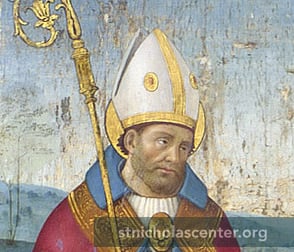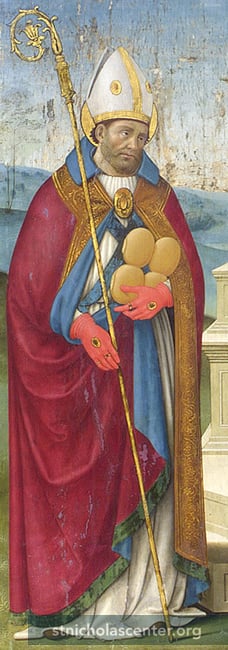Christmas This Year
Popular novelist and Pulitzer Prize winner Tarkington wrote this reflection on a 16th century painting for his friend, Earle J. Bernheimer, who issued just twelve copies in manuscript form with a black-and-white reproduction of the painting
 Indianapolis Museum of Art |
 |
Something more than a dozen years ago, at Princeton, I heard from one of the "Art Professors" that a painting by Mainardi, a fine example from the Florentine Renaissance of the high period, could be bought in New York for far less than its worth. The great Depression was then upon us; the picture had been put through an auction sale and a dealer had bid it in for a fiftieth of what had once been paid for it.
I went to his galleries; he brought out the painting and I stood puzzled before it. The central figure was that of the blonde Virgin enthroned and holding the Christ child upon her lap. That was plain enough; but who were the two tall saints flanking the throne? One, holding a book was a woman, probably identifiable as Ste. Justina; the other one was the problem—a long, thin, elderly man, bearded, ecclesiastically robed, red-gloved and carrying four loaves of bread in token of what function I couldn't guess.
One thing was certain: this ancient gentleman was immeasurably compassionate. That was markedly his expression. A deep world sadness underlay the look of pity; he was visibly a person who suffered less his own anguish and more that of others. You saw at once that he was profoundly sorry for all of humankind.
When I had the painting on my own wall at home, I found that a gentle melancholy pervaded the room and the old saint seemed to add a wistfulness. "Don't you really wish to know who I am?" he inquired to me whenever I looked his way.
I did indeed wish to know him and to understand his sorrow, which was one of the kind we call "haunting"—all the more so because it was universal. Of all the saints, he was the one who most mourned over the miseries of this tangled world. We got out our books, wrote to iconographical experts—and lo! we had our man. The sad old saint is—Santa Claus!
He is St. Nicholas of Bari and his four loaves of bread signify his giving, his generosity. In time, as the legend grew and changed, the most jocund and hearty of all symbolic figures emerged from this acutely sad and grieving one. St. Nicholas of Bari became "Old Saint Nick", "Kris-kringle" (a most twisted alliterative) and Santa Claus.
He, the troubled and unhappy, now comes laughing down the chimney, fat and merry, to be the jovial inspiration of our jolliest season of the year. We say that time changed him, made this metamorphosis; but it was we—"we-the-people"—who did it. Time only let us forget that St. Nicholas was a sorrowful man.
Mainardi put a date on the painting. It is clear and neat upon a step of the Virgin's throne—1507. In the long march of mankind, the four hundred and thirty-eight years that have elapsed since the Tuscan painter finished his picture is but a breath. St. Nicholas as we know him now, our jolly, shouting friend, a frolic for the children, may become the saddest of all the saints again, someday. What made us brighten him into Santa Claus was our knowledge that the world was growing kinder than it was in 1507.
St. Nicholas of Bari knew only a cruel world. Christmas of this year needs the transfigured image of him—the jolly one who is merry because the world is wise—and kind.
Text by Booth Tarkington, private printing, 1945. Copyright © Booth Tarkington Estate, Indiana Historical Society. Permission pending.
Illustration: Sebastiano Mainardi, Italian (1460-1513), Madonna and Child with St. Nicholas of Bari and St. Justina, oil on wood panel 63½ x 61 inches, Indianapolis Museum of Art, Gift of Mrs. Booth Tarkington in memory of her husband. Used by permission.
The painting has since been identified as signed and dated in 1507 and portraying the Madonna and Child with St. Justus of Volterra and St. Margaret of Antioch, rather than Ste. Justina and St. Nicholas, as identified by Booth Tarkington after he purchased the painting around 1930.


